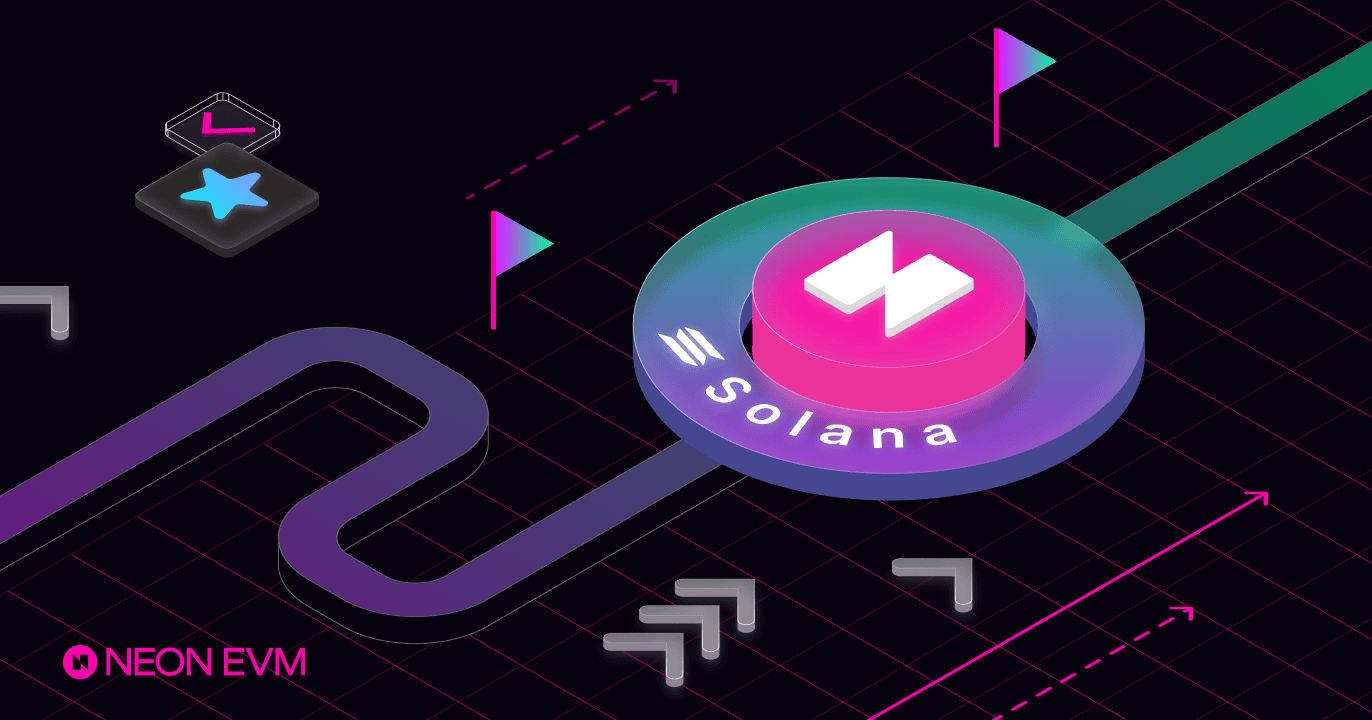
Neon EVM’s next chapter: Becoming the Fast Track to Solana for EVM developers
Reflecting on Our Past
When Neon EVM launched, our primary focus was on bringing EVM functionality to Solana, aiming to enable developers to deploy their Ethereum-compatible applications to unlock Solana’s benefits. This approach made it easy for Ethereum-based projects to leverage Solana’s fast and low-cost transactions without needing to rewrite their Solidity smart contracts.
However, the experience remained more EVM-centric, limiting access to Solana's growing native user base, liquidity, and capabilities. While the protocol operated on Solana, the user experience felt like an isolated layer accessible only to the EVM user base, and Neon EVM didn’t fully capitalize on the advantages of being part of the Solana ecosystem.
As the market’s needs evolve, so does Neon EVM.
Going forward, we are releasing our vision to serve Solana users and match EVM developers' expectations: tap into Solana native opportunities.
Neon EVM’s Transition to a Solana-Native Experience
1. Bringing EVM developers closer to Solana
- A fast track for EVM developers: Neon EVM will make it easier for EVM developers to connect to the Solana ecosystem, users, and liquidity. Instead of being perceived as an isolated layer, Neon EVM will focus on simplifying the onboarding process so that EVM projects can become accessible on Solana.
- Interact natively with Solana programs: By expanding the use cases associated with composability (here, an example of EVM interaction with Orca), we make it easier for EVM smart contracts deployed on Neon to call Solana programs and thereby leverage the growing liquidity and set of solutions built on Solana.
- Access Solana SPL tokens and leverage Solana top features and integrations: Transitioning to a Solana-native experience aims to grant EVM developers native access to Solana SPL tokens and allow them to leverage Solana's top features and integrations, such as Metaplex, Solana Pay, and token extensions.
2. Tapping into the Solana user base thanks to a unified experience
- Execution of Neon EVM transactions on the Solana network: Neon EVM transactions are currently executed on the Neon protocol through MetaMask and other EVM-centric wallets. While we stay committed to serving the EVM user's needs and maintaining the current EVM experience, we will enable Solana users to interact with applications built on Neon EVM and execute transactions directly in Solana.
- Abstracting Neon EVM for a frictionless user experience: This approach will improve the user journey by providing a Solana-like environment. It will allow them to interact with dApps on Neon EVM directly through their preferred Solana wallet (e.g., Phantom, Backpack, Solflare), without needing to transfer funds to Neon, use an EVM wallet, connect to a separate RPC endpoint, or use a gas token different from SOL. Users will interact with Solidity dApps, assuming they are written in Rust.
Why This Transition Matters
Neon EVM is redefining how dApps can thrive in a multi-chain future. Here’s how:
- Neon as the fastest way for EVM applications to access Solana: One of the key challenges for EVM protocols looking to enter the Solana ecosystem is the need for Rust developers. Since Solana is primarily built using Rust, protocols must either find developers skilled in Rust or retrain existing teams, which is a process that can be time-consuming and resource-intensive. This difficulty is compounded by the discrepancy in Solidity and Rust developer communities and applications (13000 Solidity-based dApps vs 340 Solana applications in Rust). This disparity highlights the steep learning curve and the challenges in bridging the gap between EVM and Solana development, confirming Neon EVM’s value proposition.
- Leverage Solana’s explosive growth and attractiveness: Solana has seen exponential growth, both in terms of users and builders. Its throughput, high scalability, and low transaction costs have drawn attention from a wide range of developers looking for a blockchain that can handle real-world applications. As the ecosystem has matured, it also has proven to be driven by a highly innovative mindset, with builders and use cases focused on mass adoption. With a thriving ecosystem and a strong user base, Solana is positioned to attract millions of users and key applications.
- Solana’s future opportunities: With ground-breaking developments like Firedancer, a validator client capable of reaching up to 1 million transactions per second (TPS), Solana’s performance and scalability are about to reach new heights. Neon EVM will leverage these advancements, allowing EVM dApps to tap into a blockchain that matches their ambitions.
Looking Ahead: What is Neon EVM's vision for the coming months?
Our plan involves a series of steps to translate this approach into the most valuable impact for Neon EVM ecosystem and EVM builders. Here are some key highlights of what’s to come over the coming months:
- Execution of Neon transactions with a Solana signature: We are actively researching and developing a technical solution that allows EVM transactions on Neon to be signed and executed on the Solana network. In order to unlock this key feature, our team is focused on developing technical enhancements:
- Introducing an Onchain Mempool to enable complex interactions between EVM contracts and Solana programs: Neon’s core team has introduced a "tree of scheduled Neon transactions," that allows for breaking down larger, more complex Ethereum-like transactions into smaller, independent Neon transactions that can be executed in parallel without compromising the overall transaction logic. This approach enables the support of EVM reverted transactions, improves transaction reliability, and maintains composability between both EVM and Solana ecosystems.
- Intent- based execution model: The intent-based execution model allows transactions to execute only when specific conditions are met, optimizing the efficiency and cost-effectiveness of the transaction process. Instead of executing blindly, each scheduled transaction is monitored for its intent, meaning that it only proceeds if the required criteria are satisfied. If the conditions aren't met, the transaction is not executed, preventing unnecessary gas fees and failures. This approach ensures that users pay only for successful executions, enhances the reliability of complex interactions, and allows for more intelligent and efficient transaction handling within the Neon EVM and Solana ecosystem. - Extended composability: While Neon already offers a possibility to EVM developers to call Solana programs, the current solution is only allowing Composability with “simple transactions”. However, as use cases across the ecosystem demand transactions with more advanced logic and higher Compute Unit requirements, our team is researching and developing a new version of the Composability feature. This enhancement will enable complex EVM iterative transactions to interact with Solana programs.
Are you an EVM developer interested in building on Solana? Our product team is partnering up with teams to leverage new use cases for Solana mass adoption. Get in touch and contact Florian Munoz, Head of Product, at [email protected] for an insightful conversation. Don’t miss a beat: follow Neon EVM latest updates on Discord and Twitter.

Other articles